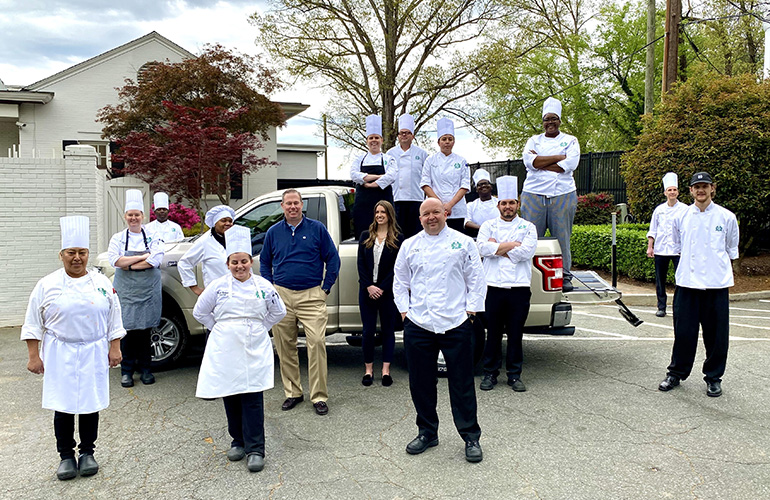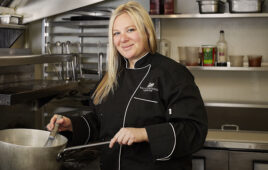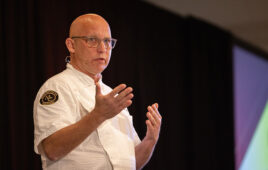 While it’s always been on the horizon, we have finally encountered the “perfect storm” of hiring in the food-and-beverage industry.
While it’s always been on the horizon, we have finally encountered the “perfect storm” of hiring in the food-and-beverage industry.
Some will say our labor shortage was created by COVID-19 and perpetuated by enhanced unemployment benefits and stimulus checks.
I only agree in part.
After all, I remember sitting with esteemed chefs at the 2019 Chef to Chef Conference discussing our respective labor challenges before most of us had ever heard of coronavirus.
What brought us to where we are? Here are my thoughts:
1. Rising Cost of Education
First, the disproportionately rising cost of education over the past twenty-five years, especially in private culinary schools, has created an extraordinary burden on students and parents alike.
While there are some incredible low-cost options for formal education on a local level, some potential cooks have simply felt shut out of the industry by the prohibitive cost of entry. Others were driven out by the combination of debt and low wages. I was one of them.
After attending a four-year college, I did not feel I could take on the additional burden of student loans associated with culinary school, so I apprenticed.
2. Old-School Mentalities
The disconnect between the generations continues to contribute to the lack of participation. I know plenty of chefs who reminisce about the rough-and-tumble days of old-school brigades. Some still cling to those sensibilities.
But the modern generation does not respond to this type of leadership, and railing against the faults of millennials, and those younger than them, only serves as a barrier to the development of needed new talent.
I, for one, believe the younger generations have dozens of strengths that we should embrace and celebrate. Their ability to multi-task, their desire to serve a larger purpose, and their capacity for empathy are all extraordinary attributes that we must harness and direct.
3. Low Wages
The single greatest contributing factor to the decline of participation in the culinary profession is our industry’s inability or unwillingness to increase wages in proportion to the cost of living.
Based on figures from the U.S. Bureau of Labor Statistics, the average wage for a line cook in the United States is $13.10 per hour, or $27,250 per year.
While that figure is based on the industry at large, it has been my experience that country clubs generally fall behind the curve on food-and-beverage compensation, even when considering that clubs do offer more humane hours and more competitive benefits.
Quick math will show that after federal, state and local taxes, a student-loan payment and modest expenses, there is quite literally less than nothing left at the end of the year.
I vividly remember those days as a line cook. I was dead broke but on fire for our craft. I remember my roommate selling weed to make rent, and I will never forget being jailed for not being able to pay for my car insurance.
Looking back, it makes me angry that we worked so hard for so little, especially at one of the most respected and affluent country clubs in America at the time. (I also came to appreciate the extraordinarily fine line that exists between being a hard-working but underpaid citizen and being deemed a criminal.)
For too long, too many operations benefitted from the inexpensive labor of chefs, cooks, and stewards. They were constantly pressing for better results while failing to increase wages at a rate that kept up with the cost of inflation and education. The stereotypical image of a screaming chef was gleefully embraced by the public and too often perpetuated within the industry.
4. Loss of Seasoned Cooks
The pandemic, once it did occur, has also had a role in contributing to the declining number of culinary professionals. Its biggest impact, I believe, was with the demographic of seasoned line cooks and stewards who exited the industry and are now reticent to return. These key employees had spent years working nights, weekends and holidays, often to the detriment of their health and personal relationships.
5. Drugs and Alcohol
Based on statistics from Drugrehab.com, our profession “leads all industries in past-month illicit drug use and past-year substance-use disorder categories by a significant margin. Hospitality ranks third in heavy alcohol consumption, behind mining and construction.”
This isn’t news to us. We have all seen it. Alcohol at the end of the shift, oxycodone to dull the pain in your knees from dropping down to check your oven 40 times that evening, then cocaine to pull you through the next 14-hour shift. Many operations have quickly terminated employees for substance abuse without ever asking the question: Why is this person self-medicating?
The Bottom Line
The COVID-19 era offered many of our long-time culinary employees their first glimpse at normality and hastened their transition to other industries with higher wages and far fewer sacrifices.
For these employees, you and I are not competing against one another any longer. We are competing against industries that understand what “essential” means, and are paying accordingly.
We are competing with construction jobs that pay $22 per hour for swinging a hammer, with weekends off, and with Amazon, which will pay an unskilled worker $18 per hour.
The bottom line is this: We face a crisis of our own making, and I bear as much responsibility for perpetuating this as anyone.
I made concessions every year on employee pay, especially in my early years as a chef when I had less political capital and no bargaining experience.
Despite our collective fault, we are not helpless bystanders with no bearing on the outcome. There is much work to be done, but the opportunity is in front of us to redefine our industry and leave it better than we found it. The challenges that we overcame to make our way to the other side of this pandemic will mean little if we do not take this opportunity to change the system that resulted in our employment crisis.
Myers Park CC’s Approach
- Increase the minimum wage for cooks and stewards.
Regardless of what the government determines to be our national minimum wage, it has been widely accepted by many that $15/hour is now defined as the minimum “living wage.”At the end of the day, the various opinions surrounding this debate do not matter, if enough people believe it to be true. The market will dictate what the minimum wage should be, and employers will not be able to fill positions without reaching it.The stewards who do not get the pay increase today can simply find a higher-paying job tomorrow, and their chefs will be left to hire someone else at a higher rate (after they have finished washing the dishes themselves).
- Invest in an Employee Assistance Program (EAP).
EAPs offer the kind of support most of us are not trained, or sometimes equipped, to handle. 2020 was a difficult year for everyone, and many of my team members needed to talk through losses, anxiety, addictions and more.I am fortunate to have found a counselor who is effective for me, and my weekly sessions make me a better human and, I hope, a better leader. Employment Assistance Programs make this kind of support available for all of our team members who might be struggling. - Become actively involved with community organizations.
Being involved in something bigger than yourself is a clear motivation for many in today’s workforce. Let your team assign someone to spearhead the club’s community engagement and facilitate opportunities to volunteer and donate leftover product.These efforts can not only lift vulnerable members of our community, they can reframe country clubs as a resource for the community.Lastly, they allow team members to feel great about their roles in serving the greater good.
- Fund the continuing education of our cooks and chefs.
This can be done in several different ways. The most obvious would be to create a General Ledger line during the budgeting process. However, if the resources for this are not readily available, turn to your vendor partners to help work towards a solution.Rebates can be utilized to fund these endeavors, and you may also be able to obtain direct donations from vendors who value your professional relationship.
The Most Important Goals and Measures
We absolutely must strive to create cultures where employees, current and potential, want to participate. We must invest in our employees, not only ensuring that they have a living wage, but that we are helping them move toward their professional goals. To do its part, Myers Park Country Club has adopted a multi-pronged approach.
We cannot measure our success only by how many medals we earn, compliments in the dining room, performance bonuses or social-media “likes.”
We must measure ourselves by the lifestyle, relative comfort, and future success that is afforded to those who look to us for leadership.
Now is the time for leaders to lead. Let’s give shape to a different vision, and truly leave our craft and our clubs better than we found them. The fight ahead to obtain the needed resources may be exhausting, but it is a fight for nothing less than the soul of our industry and the future of our craft.
Thankfully, no single one of us is in it alone.




